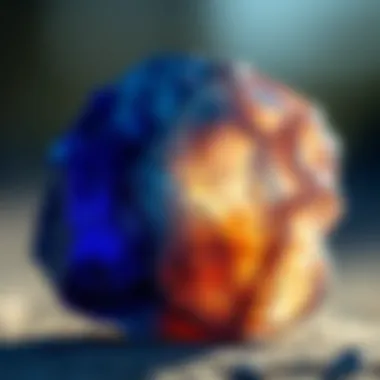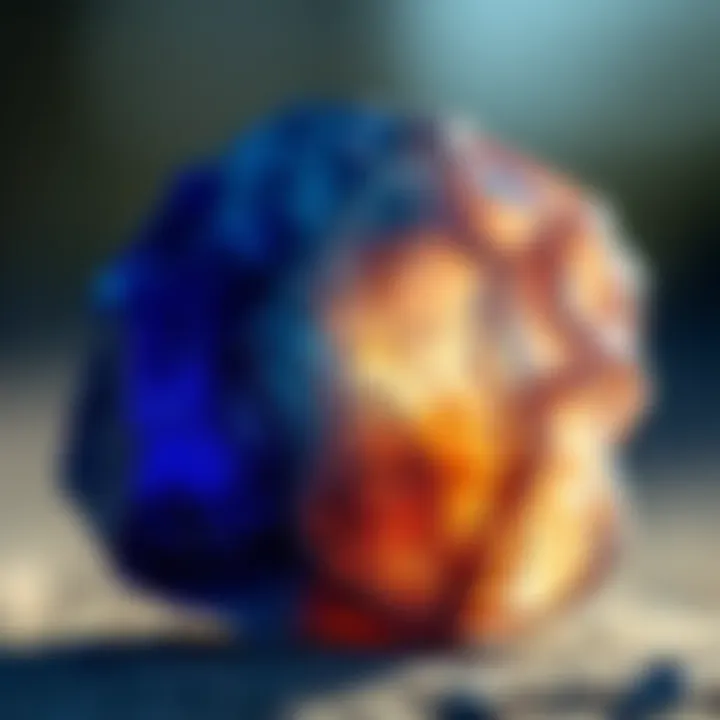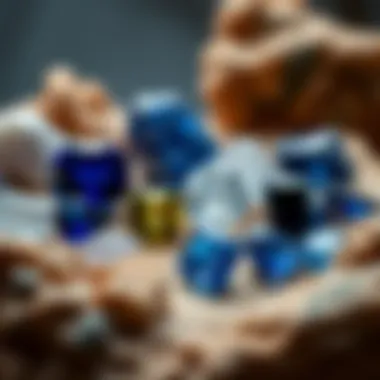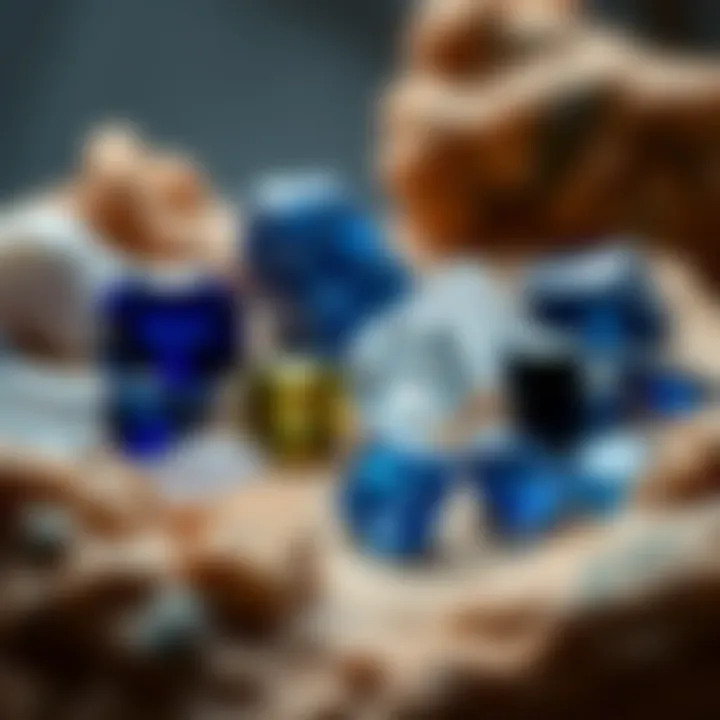Exploring the Depths of Raw Sapphire


Intro
Raw sapphire, a gem that radiates both history and splendor, has captivated numerous collectors and enthusiasts over the years. Each piece of uncut sapphire tells a story, a narrative that unfolds across time and geological transformations. From its unique geological origins to its myriad applications in various fields, raw sapphire encapsulates beauty and significance that stretch far beyond mere aesthetics.
In this article, we aim to peel back the layers surrounding this remarkable mineral, unearthing not only its visual allure but also its place in our cultural tapestry. We'll delve into its formation and properties, providing insights on identifying and evaluating this precious stone. Moreover, as we traverse through its historical significance, the article seeks to offer a comprehensive guide for both seasoned collectors and novices alike.
Understanding raw sapphire isn't merely about looking at a piece of rough stone. It’s about appreciating the complex interplay of geology, culture, and personal connection to the earth's treasures. So, let’s begin our deep dive into the world of raw sapphire.
Prologue to Raw Sapphire
Raw sapphire, a striking mineral, is not just a gem; it's a portal into the Earth’s history and an emblem of cultural significance. This section serves as a gateway into understanding the multifaceted nature of raw sapphire. One might wonder why this stone captures the fancy of collectors and enthusiasts alike. The answer lies not only in its beauty, but in the stories it tells.
Engaging with raw sapphires opens up discussions about geology, artistry, and the ethical implications surrounding their sourcing. Understanding these elements can significantly enhance one’s appreciation for the gem. In addition, the journey of raw sapphire from rough stone to polished masterpiece illustrates both the artistry involved in gem-cutting and the diverse uses of sapphires in various fields. Therefore, it is crucial to grasp not just what raw sapphire is but also the contextual framing behind its allure.
Defining Raw Sapphire
At its core, raw sapphire refers to unraveled corundum crystals that showcase a rich tapestry of hues, stemming primarily from iron and titanium content. Unlike the polished gemstones seen in jewelry stores, raw sapphires are unrefined and often come enveloped in a layer of earth, making their actual value somewhat hidden. These stones possess a hardiness that’s reflected in their rankings on the Mohs scale, where they sit comfortably at 9, just behind diamond.
Often, people think sapphires are merely blue. Although the blue variant garners high admiration, raw sapphires can also exhibit tones of yellow, green, or even pink. This range of color is derived from variations in elemental impurities and gives each stone its own unique flair. When collectors and gem enthusiasts refer to the term “raw sapphire,” they signify a stone that carries with it both geological and aesthetic significance, crafted by nature over eons and awaiting discovery.
The Journey From Ore to Gem
The metamorphosis from raw ore to a dazzling gem begins deep beneath the Earth’s surface. Sapphires crystallize under immense heat and pressure in metamorphic rocks, primarily within a setting called granite or basalt, where the necessary aluminum and oxygen atoms come together. The process takes millions of years, and once surface erosions reveal these precious stones, they become ripe for extraction.
Mining for raw sapphires can be as varied as the stones themselves. It involves techniques ranging from small-scale artisanal mining in places like Sri Lanka to larger operations in Madagascar. Each method has its own set of challenges and benefits, affecting not only the stones’ purity but also the surrounding ecological systems and community livelihoods.
After extraction, the stones might go through preliminary processing to remove any dirt and impurities. What might astonish many is how every raw sapphire holds potential; with the right cut, they can transform into gems that exhibit a play of light and color that commands attention. The journey from ore to gem isn’t just a physical transformation; it's a narrative that speaks of the Earth’s lineage and the human touch that brings these stones to life.
Geological Origins
Understanding the geological origins of raw sapphire provides a solid foundation for appreciating its beauty and value. This segment not only tells us where this remarkable gem comes from but also informs us about the natural processes that give rise to its characteristic features. Analyzing mineral composition and formation processes, we can decipher the complex interactions that turn simple elements into stunning gemstones.
Mineral Composition
Raw sapphire is primarily composed of corundum, which is an aluminum oxide (Al2O3). However, the intrigue about sapphire starts with the trace elements that color it. For instance, the presence of iron and titanium can result in vibrant blue hues, while chromium gives rise to the stunning pink shades we associate with rubies, which are simply red sapphires.
Consider this:
- Aluminum (Al): The backbone of the mineral structure.
- Oxygen (O): An essential component that works with aluminum to create corundum.
- Trace Elements: Just small amounts can significantly alter color. Iron, for example, creates blue and yellow shades.
The varied mineral composition directly impacts the commercial value of a sapphire. A stone with an intense blue color, free of inclusions, fetches a higher price compared to a pale or heavily flawed one. It's crucial for collectors to understand these nuances to make informed purchases.
Formation Processes
The process by which sapphire forms is as compelling as the stone itself. Sapphires originate in metamorphic rocks through a long and complex journey involving high temperatures and pressures over millions of years. They can also be found in igneous rocks, particularly in areas with volcanic activity.
This transformation often incorporates several steps:
- Metamorphism: The initial transformation occurs when existing rocks are subjected to extreme heat and pressure, often deep within the Earth's crust.
- Crystallization: As minerals develop and crystallize, corundum emerges among other slick forms. During this stage, the presence of different elements determines the stone’s final color and quality.
- Erosion: Eventually, erosion brings these minerals closer to the surface, where they might be discovered or mined. Rivers can carry sapphires, forming deposits in what miners call alluvial locations.
"From its fiery creation deep within the Earth to the gentle embrace of riverbeds, sapphire's journey is one of both transformation and survival."
In summary, understanding the geological origins of sapphire is pivotal for rock and fossil collectors. By grasping the mineral composition and formation processes, collectors can more effectively identify quality stones and appreciate their significance in nature. This deep understanding enriches the collecting experience, making it both educational and thrilling.
Physical Properties
The physical properties of raw sapphire play a pivotal role in understanding its value and appeal, especially for collectors who keenly observe not just aesthetics but also the gem's intrinsic qualities. In the world of geology and gemology, these properties offer insights into the stone's formation, its uniqueness, and its potential uses.
Color Variations


When we think of sapphires, the deep blue hue often comes to mind. Yet, the beauty of raw sapphire lies in its diverse color spectrum. From pastel pink to vivid yellow and even the rarest of orange hues, color variations are determined largely by the presence of trace elements such as iron and titanium.
Some collectors seek rare color combinations, known as parti-colored sapphires, where distinct hues appear in the same stone. For example, a sapphire that transitions from green to blue can evoke strong interest and fetch a higher value on the market. Here’s a brief list of notable colors:
- Blue: The most recognized color, with varying depths of hue.
- Pink: Often found in lighter shades, sometimes dubbed “pink sapphire.”
- Yellow: A striking golden tone, yet less commonly sought after compared to blue sapphires.
- Green: Rare and typically more valued when rich in color.
Understanding these color variations helps collectors gauge rarity and market trends, making it a vital aspect in evaluating raw sapphire.
Clarity and Luster
Clarity speaks volumes about the quality of raw sapphire. In gemology, it refers to the presence or absence of inclusions and external flaws. Stones with fewer inclusions tend to exhibit better clarity, presenting a purer light reflection, which enhances their overall brilliance. However, certain inclusions, like silk or rutile needles, can add character, indicating a sapphire's natural origin rather than mass-produced quality.
The luster of a sapphire, often described as vitreous or glass-like, is equally important. A high luster not only enhances its aesthetic appeal but serves as a marker of quality. Raw sapphire boasting excellent clarity and luster is often sought after by collectors as it embodies not merely beauty but also exceptional craftsmanship in nature.
Historical and Cultural Significance
The historical and cultural importance of raw sapphire cannot be understated. These striking gemstones have woven themselves into the very fabric of human experience, captivating creators, leaders, and dreamers alike throughout history. This section will delve into two key aspects: the presence of sapphires in antiquity and the varied symbolism attached to them in different cultures, thus enriching our understanding of raw sapphire beyond its mere aesthetic appeal.
Sapphires in Antiquity
From ancient times, sapphires were not just cherished for their stunning beauty but were also regarded as objects of power. The earliest records of sapphire use date back to ancient civilizations, where they were extracted and utilized for various purposes. For instance, in Ancient Persia, sapphires were believed to be the remnants of fallen stars, granting wisdom and protection to those who possessed them. It was thought that the blue hue reflected divinity, and thus, if worn by rulers, it would ensure celestial favor.
Furthermore, ancient Greeks and Romans honored sapphires, associating them with multiple deities. Philosophers believed that these gems hosted the wisdom of the Earth itself. Sapphires were also adorned on royal coronets, symbolizing heaven's blessing upon the ruling class. The infamous Persian King, Darius, was known to wear sapphires, which he believed brought good fortune against treachery.
Another remarkable example from history is the famous "Star of India," a magnificent star sapphire that once belonged to famous collector J.P. Morgan. Dating back over a century, this stone reveals the long-standing fascination with sapphires, demonstrating how they have transitioned from rough stones to prized possessions, as well as invoking unique stories across different eras and societies.
Symbolism Across Cultures
Sapphires, often referred to as the gem of nobility, carry a profound wealth of symbolism across cultures. In Hinduism, this gemstone is associated with the planet Saturn, and it is believed that wearing a sapphire can bring peace and tranquility to the mind. In this context, it becomes a tool for spiritual growth and self-discovery.
In Christian traditions, deep blue sapphires symbolize heaven, purity, and wisdom. It is said that these stones were used to create the settings for some of the most revered religious artifacts, believed to connect the earthly realm to the divine.
In various African cultures, blue sapphires represent harmony and protection. They are often worn as a part of ceremonial attire, reflecting not only beauty but also the wearer's strength and resilience.
Across different parts of the world, sapphire is seen as a powerful talisman against misfortune and harm, believed to bestow strength and courage upon its wearer. This multi-faceted symbolism, enriched by history and tradition, ensures that sapphires remain a crucial part of cultural narratives.
"The tapestry of human history is interwoven with threads of sapphire, each stone carrying tales of power, protection, and cosmic ties across diverse cultures."
Mining and Sourcing
The mining and sourcing of raw sapphire is a critical aspect that intertwines both the economic factors and ethical considerations surrounding this captivating gemstone. Understanding where and how sapphires are mined not only informs collectors about the quality and uniqueness of their stones but also sheds light on larger issues like environmental impact and labor practices. This section will explore significant factors in mining raw sapphire and provide insight on various sourcing locations that collectors ought to be aware of, enforcing the bond between a stone’s origin and its appeal.
Ethical Considerations
In recent years, the conversation surrounding ethical sourcing has intensified, especially for gemstones. It can be tempting to chase the flash of the gem without thinking about how it got to your jeweler's hands. Ethical sourcing involves ensuring that the gemstones are mined in a manner that respects human rights and environmental sustainability.
When it comes to sapphires, here are a few critical points:
- Labor Practices: Many regions where sapphires are mined have faced scrutiny for labor violations. Ensuring fair wages and safe working conditions are pivotal.
- Environmental Sustainability: Traditional mining methods can leave a lasting imprint on the landscape, often leading to deforestation and habitat destruction. Collectors are urged to research and support sustainable mining operations that take steps to minimize their ecological footprint.
- Traceability: Knowing where a gemstone comes from is essential for ethical transparency. Sellers that offer traceable stones provide valuable information regarding the mine's practices, which fosters trust between buyer and seller.
"The true value of a gemstone isn't solely in its visual allure, but in the story it carries from its source to your hands."
It’s essential for collectors to inquire about the origin of their sapphires, raising awareness of the importance of these ethical considerations. By doing so, collectors make informed choices, ensuring their acquisitions reflect their values.
Major Mining Locations
Sapphires are mined in various locations around the globe, each offering stones with unique characteristics influenced by their respective environments. Understanding these major mining areas can guide collectors in sourcing high-quality sapphires that align with their interests.
- Myanmar (Burma): Widely regarded as the premier source for high-quality sapphires, Burmese stones are known for their deep blue hues and excellent clarity. The quality of these sapphires stems from their origin in the Mogok region, which has been revered for centuries.
- Sri Lanka: Often referred to as Ceylon, Sri Lanka produces a diverse array of sapphires in various colors. The country’s alluvial deposits and rock formations contribute distinct qualities to its sapphires, making them a favorite among collectors.
- Madagascar: This island nation has gained recognition for its vibrant and diverse sapphire colors. The relatively recent discovery of sapphire deposits here has intrigued collectors, as they often yield unique stones different from traditional sources.
- Australia: Known for its fancy sapphires, Australian varieties often feature lighter colors and a range of shades. These sapphires provide collectors with diversity in their collections and frequently come with an accessible price point.
- Montana, USA: For those who prefer domestic stones, Montana offers sapphires that range from a soft blue to rich yellows and greens. The accessibility and the local aspect of these stones hold value for many collectors.
Collecting raw sapphires requires not only an aesthetic appreciation but also an understanding of how their origins and mining practices influence their value. Investing time to know these aspects can significantly enrich a collector’s experience.


Value and Market Trends
Understanding the value and market trends for raw sapphires is crucial for anyone invested in the gem and mineral trade. For collectors, jewelers, and investors alike, these trends not only dictate pricing but also indicate the health and future prospects of the gemstone market. As enthusiasts delve deeper into the sapphire phenomenon, being aware of its fluctuating values can enhance acquisition strategies and collecting practices. This section focuses on the primary factors that influence sapphire value and sheds light on current market dynamics, preparing collectors for informed decisions in this vibrant arena.
Factors Influencing Value
To comprehend what shapes the value of raw sapphires, consider the following elements:
- Color: The most captivating aspect of a sapphire is its color; deeper blues tend to command higher prices compared to lighter shades. The presence of secondary hues, like green or violet, can moreover influence desirability.
- Clarity: Like diamonds, sapphires are also graded based on their clarity. Stones with fewer inclusions are more valuable. Unlike other gems, however, some inclusions are accepted in sapphires, and in some cases, they can even add character.
- Carat Weight: Larger stones often equate to higher values, but this isn't a hard and fast rule. If a stone possesses outstanding color and clarity, even smaller stones might fetch a hefty price.
- Origin: The source of the sapphire significantly affects its market value. For instance, sapphires from Kashmir or Burmese are often considered superior due to their rich hues and unique qualities, leading to a spike in value compared to stones from newer mining sites.
- Treatment: The treatments a sapphire undergoes, such as heating or dying, plays a pivotal role in determining its worth. Unheated sapphires typically hold greater value, as they are perceived as more natural and, hence, of higher quality.
In summary, while collecting raw sapphires, understanding these influencing factors can not only provide insights into current values but also inform potential sellers about the worth of their stones.
Current Market Trends
Recent years have highlighted some interesting trends in the sapphire market:
- Sustainability and Ethical Mining: As consumers become increasingly socially conscious, ethically sourced sapphires are rising in demand. The market sees a growing preference for stones that are mined without harmful environmental impacts or worker exploitation. This shift is prompting some miners to adopt eco-friendly practices.
- Online Sales: With the rise of e-commerce, more collectors are turning to online platforms to acquire sapphires. This expansion in the marketplace allows for a broader range of prices and often eliminates geographical barriers that previously restricted buyers.
- Investment Potential: More collectors are viewing sapphires not just as collectibles but as tangible investments. The rarity of certain colors and clarity levels can entice investors, leading to increased values over time. With luxury goods often being seen as a hedge against inflation, sapphires fit into this growing investment trend.
- Social Media Influence: The power of social media and celebrity endorsements has dramatically altered how gemstones are perceived. A sapphire worn by a celebrity can spark trends that directly impact demand and, thus, the market price.
In summary, the sapphire market is seeing a blend of tradition and modern innovation. By keeping abreast of these trends and understanding the various factors at play, collectors can navigate the intricate landscape of sapphire values with greater confidence.
"The beauty of the sapphire lies not just in its brilliance but in the layers of history and value that it carries with it."
For further insights and community discussions, explore platforms like Reddit and Wikipedia that delve into the emotional and financial aspects of sapphire collecting.
Collecting Raw Sapphire
Collecting raw sapphire can be a fascinating journey for gem enthusiasts and rock collectors alike. This pursuit enriches not just one’s collection but also deepens appreciation for the natural world and the intricate processes that create these stunning gemstones. Such a passion not only celebrates the beauty of raw sapphire but also instills a sense of responsibility towards ethical sourcing and environmental awareness.
Starting a Collection
Starting a collection of raw sapphires requires careful planning and consideration. First, potential collectors should educate themselves about the characteristics of raw sapphires, including their various forms and colors. Since sapphires can be found in shades of blue, yellow, pink, and even colorless, discerning one type from another can be an adventure in itself.
A good place to begin is researching locations where raw sapphires are commonly mined, such as Sri Lanka, Madagascar, and Montana in the United States. Building a simple inventory log can help track what you own. This log can include details such as the stone’s origin, size, and any unique traits that make it stand out.
"The beauty of raw sapphire lies not just in its color but in the stories each stone tells. "
When making your first purchase, consider starting small. Choose a few pieces from reputable sources, such as gem shows or established dealers. This will allow you to get a feel for the market before making larger investments. Don’t forget to inquire about their extraction practices, ensuring they align with ethical guidelines.
Identifying Quality Stones
Identifying raw sapphires of quality entails knowing what to look for. Not all sapphires are created equal; factors like color, clarity, and durability factor into their overall appeal and value. For instance, a vivid blue sapphire with minimal inclusions will typically be more desirable than one with a dull hue and visible blemishes.
Some key indicators of quality include:
- Color: Richer tones are often preferred. Pay close attention to zoning, where hues may vary within the same stone.
- Clarity: While some inclusions are normal and can even add character, stones without visible imperfections should be prioritized.
- Size and Shape: Larger stones are rarer, but unique shapes can enhance their allure.
- Luster: A stone that exhibits a high level of luster can indicate better quality.
Networking with Other Collectors
Networking with other collectors can tremendously enhance your collecting experience. Joining local gem and mineral clubs or online communities, like Reddit’s r/mineralcollectors, provides opportunities to share knowledge, trade stones, and learn about upcoming events.
Engaging with a community can offer several benefits, such as:
- Knowledge Sharing: Experienced collectors often have valuable insights regarding sourcing and appraising stones.
- Trade Opportunities: Networking allows you to trade or purchase pieces you might not find elsewhere.
- Events and Shows: Members often attend gem shows together or host informational workshops.
Attend local rock and gem shows to meet fellow enthusiasts, where the collective passion can be infectious. These gatherings not only serve as a marketplace but also as a forum for learning, often featuring guest speakers and informative panels on collecting practices.
Cultivating these connections can lead to enriching your collection while fostering friendships founded on a mutual love for sapphires and the beauty of the earth.
Care and Preservation of Raw Sapphire
Caring for and preserving raw sapphire is a vital topic for collectors and enthusiasts alike. Unlike polished gemstones, raw sapphires have unique characteristics that require special attention. The natural state of these stones may make them susceptible to damage if not handled properly, making effective preservation essential to maintain their integrity and beauty.


The benefits of proper care are numerous. First and foremost, it ensures that the gems remain in good condition for future generations. A well-maintained raw sapphire can not only retain its value but can also increase in worth over time. Additionally, understanding the nuances of gemstone preservation heightens one’s appreciation for the mineral, allowing collectors to form a deeper bond with their collection.
Here are some considerations that every collector should keep in mind:
- Environmental Factors: Temperature fluctuations and humidity can adversely affect raw sapphires. Extreme conditions may lead to chemical reactions or physical deformation.
- Physical Impact: Although sapphires are resilient, rough handling can chip or scratch them, undermining their natural allure.
- Cleaning: Inadequate cleaning can lead to residue buildup, obscuring a stone's true beauty.
Cleaning Techniques
Keeping raw sapphires clean is foundational to their care. However, the cleaning process requires a gentle touch and an understanding of the material's properties. Here are some effective techniques:
- Soft Cloth Wipe: Use a microfibre cloth for daily dusting. This method is gentle and won't risk scratching the stone.
- Water Rinse: For deep cleaning, a lukewarm water rinse is often enough. Avoid hot water, as it can cause thermal shock.
- Mild Soap Solution: Create a solution with a few drops of a gentle dish soap in warm water. Soak the sapphire briefly, then use a soft brush to remove stubborn dirt.
- Avoid Harsh Chemicals: Products containing bleach or acid should never be used, as these can cause irreparable damage.
"The essence of a good preservation regime lies in its simplicity and adherence to the stone's natural state. Less is often more."
Storing Safely
When it comes to storage, creating the right environment is critical. Here are steps to safely store raw sapphires:
- Individual Storage: Each stone should have its own compartment to prevent scratches from contact with other stones.
- Soft Linings: Use a container lined with a gentle material like velvet. This will cushion the stones and protect them from impacts.
- Cool, Dry Location: Ensure that the storage area is away from direct sunlight and low humidity to avoid potential deterioration.
- Regular Inspection: Periodically check the stones for signs of damage or deterioration. Early detection permits corrective measures before problems escalate.
Incorporating these care and preservation techniques into your routine can significantly extend the life and beauty of raw sapphires, ensuring they remain captivating treasures for years to come.
Applications of Raw Sapphire
The significance of raw sapphire extends beyond its enchanting beauty. This mineral has carved a niche for itself in various sectors, serving both aesthetic and practical purposes. A thorough understanding of its applications not only enriches the appreciation of this gem but also highlights its importance in contemporary contexts. There’s a lot to unpack, from jewelry to groundbreaking industrial uses; raw sapphire plays a key role that many might not fully recognize.
Gemstone Use
The allure of raw sapphire as a gemstone remains unmatched in the world of jewelry. Its rich hues, ranging from deep royal blue to vibrant yellow, have enchanted individuals for centuries. But what underlies this appeal? Two primary elements: rarity and symbolism.
- Market Demand: As collectors know, the demand for sapphires is consistently high. This drives values up, making quality raw sapphire both a precious investment and a prized possession.
- Craftsmanship: With raw sapphires being cut and polished, artisans often elevate their beauty, transforming them into statement pieces. Family heirlooms, engagement rings, and luxury adornments often feature them prominently.
- Symbolism: Beyond their physical charm, sapphires are steeped in meaning. They symbolize wisdom and royalty in various cultures, making them a favored choice for significant personal milestones.
Incorporating raw sapphires into jewelry isn’t merely about aesthetics; it's an art form that speaks volumes about heritage and personal significance.
Industrial Uses
Raw sapphire's utility extends far beyond adornment. It emerges as a critical material in multiple industrial fields, showcasing its resilience and versatility.
- High-Temperature Applications: Due to its exceptional thermal resistance, sapphire is indispensable in high-temperature settings. For instance, in scientific research and electronics, sapphire substrates are used for mounting semiconductor devices.
- Optical Components: The clarity and hardness of raw sapphire make it an optimal choice for optical lenses and windows, particularly in high-stress environments. These applications span industries including aerospace, military, and even consumer electronics, where sapphire glass is employed for screens and watch faces.
- Scientific Instruments: In laboratories and research environments, sapphire finds its place in a variety of instruments. It can be used for specialized sensors due to its durability and ability to withstand harsh chemicals and temperatures.
"The value of raw sapphire transcends mere beauty; it manifests in its adaptability in high-stakes environments, showcasing nature's own engineering marvel."
Understanding the diverse applications of raw sapphire sheds light not only on its worth but also on its crucial role across various sectors. Enthusiasts and collectors can appreciate the gemstone not just for adornment but also for its contributions to science and technology.
Finale and Future Directions
The exploration of raw sapphire not only highlights its captivating beauty but also reveals its significant implications in various sectors. As we come to the end of this comprehensive journey, it’s vital to recognize the enduring relevance of sapphire in modern culture and the prospects it holds for the future. This conclusion serves as a bridge, connecting the insights gleaned throughout the article with what lies ahead.
Sapphire in Modern Culture
Sapphires hold a prominent place not only in the jewelry market but also in art and design. These striking stones adorn royal crowns, making them a symbol of power and prestige across centuries and cultures. In contemporary society, the meaning of sapphire has expanded to encompass various values, including integrity, loyalty, and wisdom.
Moreover, the popularity of sapphires has also infiltrated fashion, with designers seeking the vibrant hues that this crystal offers. High-profile celebrities often sport sapphire jewelry, turning it into an emblem of sophistication. The engagement ring market, in particular, has witnessed a surge in interest for sapphire, especially among couples seeking alternatives to traditional diamond rings. This signifies a shift in cultural values, where unique expressions of love take precedence over convention.
- Artistic Expression: Artisans utilize sapphires in craftsmanship, producing unique designs that meld tradition with modern aesthetics.
- Fashion Statements: Designers incorporate sapphires not just in jewelry but even in clothing and accessories.
- Symbolism in Events: Sapphires are often gifted on significant anniversaries or milestones, underlining their lasting appeal and significance.
"Sapphires symbolize more than beauty; they represent the very essence of commitment and enduring love."
The Future of Raw Sapphire
Looking ahead, the landscape for raw sapphire is filled with potential and ongoing changes. Advances in technology may play a substantial role in how sapphires are sourced, evaluated, and utilized. The role of synthetic sapphires cannot be overlooked; they are gaining traction due to their affordability and identical appearance to natural stones. This brings forth an ethical debate among collectors and enthusiasts.
Additionally, sustainability initiatives are likely to shape the mining industry in the coming years. Responsible sourcing practices are becoming increasingly vital, pushing for transparency in the supply chain. Rock and fossil collectors may increasingly seek to align their collections with eco-friendly principles, ensuring their passion does not come at the expense of the environment.
There’s also potential for sapphires in technology. Due to their hardness and heat resistance, sapphires have found a niche role in electronics. As innovation thrives, we may find sapphires used in new ways, far beyond traditional jewelry.
In summary, the future of raw sapphire is bright, filled with opportunities for exploration, appreciation, and responsible sourcing. By understanding what has shaped the past and present of this stunning gem, collectors and enthusiasts can prepare for a future that holds as much wonder as the sapphires themselves.



